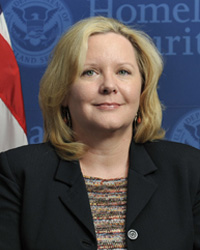
New interagency group to show resistance to the cloud is futile
The General Services Administration has put together five working groups in a new cloud center of excellence to address acquisition, value and training challenges...
It would be an understatement to say David Bray, the Federal Communications Commission’s chief information officer, is a strong proponent of cloud computing.
It also would be an understatement to say Bray’s beliefs about the power of cloud doesn’t always jive with his colleagues.
Few CIOs are comfortable with Bray’s vision for government and the cloud — even six years after the Office of Management and Budget issued its cloud-first policy.
“We can take more advantage of things like artificial intelligence and machine learning once we’ve moved all of public service to the cloud, and right now there has been a lot of resistance, some of it just the concern of those who are currently doing their jobs that are familiar with the client-server model,” Bray said during the recent Government of the Future conference sponsored by Verizon in Arlington, Virginia. “If you don’t get them comfortable with cloud and comfortable with relying on partners beyond the scope of their agencies, they are kind of concerned they may not be able to observe blinking lights. But we’ve got to move to the cloud as quickly as possible, whether it’s private cloud for the Department of Defense and the Intelligence Community or public cloud for the rest of the civilian agencies.”
Bray said government has to get out of the business of writing its own code, out of the business of hosting its own infrastructure and maybe most importantly, rely on the commercial sector to provide reusable applications that agencies can stitch together to meet their missions.
Bray isn’t just talking the talk, but walking the walk, as the FCC has moved a large portion of its technology to the commercial cloud. By doing that, the FCC cut spending on legacy systems and operations and maintenance by 35 percent.
So it’s no wonder that when the General Services Administration began searching for a chairman of its new cloud center of excellence, Bray was the natural choice.
“The center of excellence aims to see what we can do to accelerate agencies’ move to the cloud,” Bray said in an interview after his panel. “We have to figure out how to provide usability and reduce the time to roll out cloud services without taking away the autonomy agencies need to meet their missions.”
Bray said he’d like to see an a la carte cloud service catalog of pre-negotiated software- and platform-as-a-service so agencies can quickly obtain the software instead of waiting six months to get it in place.
“We can get other agencies to where we are at at the FCC where you can turn in less than 48 hours and get a working prototype for your new secretary or your new agency head,” he said.
The center of excellence is trying to address three cloud barriers through five working groups:
- Acquisition — Bray said there are several myths about how to buy cloud that need to be busted. At the same time, a second working group is looking at how best to set up an a la carte catalog.
- Value proposition — The goal of this working group is to evolve the discussion about cloud from just one about technology to one about transforming the way agencies operate. Bray said it’s clear that legacy IT slows you down, but through the cloud, agencies can simplify and change their service delivery model.
- Education and workforce training — Two working groups are looking at how agencies can better understand how to operate in a cloud environment from technology, contracting and mission delivery perspectives.
The working groups have met twice so far and GSA is providing full-time support staff.
Bray said the goal is to deliver a report to OMB and GSA with consensus recommendations for acquisition, policy and other changes.
He said then the center will go out to industry for further feedback.
OMB recognized over the last few years agencies needed more help in moving to the cloud. It had been developing new guidance over the past year based on common threads across the government of what is blocking cloud adoption. It’s unclear what will happen to that guidance under the Trump administration.
But in the meantime, having a center of excellence could help address many of those challenges.
Keith Trippie, a former executive director of the Enterprise System Development Office at the Homeland Security Department, said cloud is a complete shift for most agencies and even after dipping their foot in the water, more help is needed.
“The market is ready for more lessons learned to be shared, as well as more tools, more training and more education,” said Trippie, who is now CEO of Shop4Clouds.com. “There needs to be training for CFOs, contracting officers and program people and others because they all are in the supply chain of delivering IT.”
Trippie said center must provide actionable information, ranging from prebuilt templates for contracts to business and technology outcomes that people can plug and play into their own statement of objectives or statement of work.
“The other thing the center needs to understand is as they put tools out there, they have to keep up with different cloud technologies,” he said. “If you are buying a server, a switch or a router or software, typically those don’t change every few months. But with cloud, new features and capabilities can come out weekly and it’s nearly impossible to keep up. And because it’s hard, people can push back. So the tools that allow people to do math and understand what the best viable options are, and even more automating shopping will be helpful.”
Mark Forman, a former administrator of the Office of E-Government and IT and now global head, vice president and general manager of Unisys’ public sector division, said the center of excellence is really a change management exercise.
“Industry will service whatever the government wants to pay for, obviously will do a good job, but the change management on the demand side has to happen within government, and that’s why leading practices agencies like GSA can apply new digital marketing techniques,” he said. “There is a common pattern here with David and others jumping in to catalyze the process. When you have some people at the leading edge as early adopters then you have key agencies that once they adopt it everyone will follow. These leading adopters have jumped in and figured out who to get tremendous benefits and want to use their insights so their colleagues can get the same benefits.”
Forman said on a global scale, governments are using the broker model to move to hybrid clouds. He said increasingly cloud is about shared services and more specifically, getting customers to understand the difference between staying in their current set ups and going this new approach.
“The cloud shared service model is taking a services catalog and optimizing it. Then agencies can see what they are buying and what they are paying for the service,” he said. “This model contrasts customization where you are paying a lot of money to keep your system or software secure and modern. But having a catalog that says ‘I get X and it costs me Y and I can order more of X for some multiple of Y’ is the kind of transparency that agencies can understand and will push them toward these cloud services.”
Trippie said the center of excellence is coming at the right time, early enough in the move to the cloud that it can have a real impact because only 5-to-10 percent of agency infrastructure is in the cloud. He said four or five years ago agencies weren’t ready for these kinds of insights.
Return to the Reporter’s Notebook
Copyright © 2025 Federal News Network. All rights reserved. This website is not intended for users located within the European Economic Area.
Jason Miller is executive editor of Federal News Network and directs news coverage on the people, policy and programs of the federal government.
Follow @jmillerWFED





